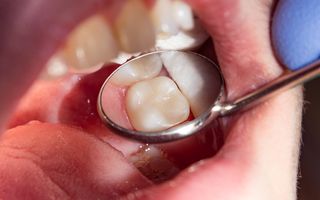
Dental fillings are the best way to treat cavities in your teeth. It’s a quick and simple procedure that you can have done on your lunch break.
Not only will a filling improve your oral health and avoid further damage to your teeth, it will also avoid any further pain or discomfort caused by the cavity, allowing you to enjoy a healthier, happier smile.
More than 90% of Australians have experienced decay in their permanent teeth, making dental fillings one of the most common dental procedures in the country.
What are dental fillings?
When you have a cavity in your tooth, it means there is a hole in the centre of that tooth. These holes are bad for a number of reasons.
Cavities can expose the nerves in your teeth, which can cause anything from minor discomfort due to greater sensitivity to hot and cold food and drink, to significant pain due to nerve damage. Additionally, if the nerve dies, you will likely need a larger procedure to treat the tooth, such as a root canal.

Cavities can also weaken the tooth itself, which can lead to further chipping, cracks, and damage.
For these reasons, the hole will need to be cleaned and filled with a ‘filling’ to avoid pain, discomfort, and further damage to the tooth and your overall oral health. These fillings are usually made from a material called ‘amalgam’, but can also be made from composite resin, gold, or porcelain (more on these materials below).
At National Dental Care South Terrace, your dentist will suggest the best option for your teeth - it usually depends on the placement of the tooth that needs a filling - and you can make the decision for the best filling material together.
The different types of filling materials
There are several options for the actual material filling your tooth. Your dentist will recommend the best for your situation:
Amalgam fillings
Amalgam fillings have been in use for over 150 years and are used less and less these days. They're a mix of metal alloys (an amalgam) that include silver, tin, mercury, and copper. An amalgam filling is soft and fills in the minute crevices of the cavity, but hardens quickly. Due to the silver colour, these fillings can be visible in the mouth.
Composite resin fillings
Composite resin fillings are quite popular as they match the natural colour of the tooth. Composites are a material made of resin that is soft and malleable, so can be easily moulded to fit the cavity. A blue light shined on the composite filling hardens it in place. These resins are extremely durable and may be used as a replacement for a chipped, stained, or leaking filling.
Gold fillings
Gold fillings are not very common these days, although they will not corrode, and are quite durable. The downside to a gold filling is that it contrasts with natural tooth colour and is more expensive.
Porcelain fillings
Porcelain fillings are less common, and are used for inlays and onlays. They require two steps to complete, and are usually reserved for occasions when the bulk of the tooth structure is compromised. The porcelain can be matched to your tooth colour for a natural appearance and is stronger than composite.

The advantages of dental fillings
Dental fillings are a popular option for the following reasons:
- Prevent further damage and discomfort: A lot of dental discomfort and damage comes from cavities and dental decay, and a dental filling is a great way to stop the damage and treat the pain.
- Quick and easy: Dental fillings are extremely quick and easy. Most people will be in and out within 30 minutes, so it can be completed during a work break.
- Long-lasting: With good dental care, dental fillings will generally last for at least a decade. Fillings made from gold can last for even longer, for as much as 20 years or more.
How do dental fillings work?
Even if you think you have a cavity, your dentist will still want to book a check up to inspect and confirm the issue. They will then book a second appointment in order to have the filling done.
Here is what to expect during your dental filling appointment at National Dental Care South Terrace:
- Your dentist will inject a local anaesthetic to completely numb the area
- They will use a special tool to remove the decay from the tooth
- They will fill the cavity
- They will shape and polish the tooth so it feels natural to bite onto
- The area will still feel numb for a few hours following the treatment
- The whole treatment will usually only take 20-30 minutes
- The site may feel a little tender for the next day, so avoid biting down on hard foods
- Your dentist will check on the filling during your next routine appointment
How do I know if I have tooth decay?
During routine appointments, dentists will check for tooth decay with a visual inspection and x-ray scans. They may discover tooth decay during this process.
However for many people, the first signs of decay are found at home. Tooth decay often causes discomfort and pain, leading to an appointment with the dentist.
These are some of the signs that you've got tooth decay:
- Sensitivity when you eat hot, cold, or sugary food or drinks.
- An ache around a tooth.
- Pain when you bite down.
- A hole that you can feel with your tongue, or see when you look in a mirror.
- Black, brown, or white staining on a tooth.
How to avoid tooth decay
While tooth fillings are a great option for treating tooth decay, it’s always best to avoid getting cavities in the first place. This means brushing for two minutes twice per day, flossing every day, and avoiding consuming lots of sugary food and drink. That’s because plaque and bacteria in your mouth can feed on sugars and build up on your teeth, where they erode the enamel and cause cavities and other damage.

Taking care of your teeth is crucial to your overall health, as there are links between oral health and heart disease, obesity, and diabetes. Smoking and other bad habits exacerbate already compromised dental health for adults, so it's important to maintain a great oral health routine and regular dental check-ups.
There is a chance that even the most dedicated brushing and flossing routine won't be enough to keep tooth decay at bay.
Some people have a predisposition for teeth that leach minerals (demineralisation), which softens them, and others may have underlying health issues that weaken teeth and lead to decay. Regular check-ups are therefore vital, as they can keep an eye on your teeth for signs of tooth decay. This may help you be able to avoid cavities before they occur.
Whether you think you need a filling or would like a check-up to help avoid needing fillings in the future, get in touch with our friendly team today to schedule an appointment at National Dental Care South Terrace.
Frequently asked questions
A tooth filling will vary in cost depending on a number of factors, including the placement of the tooth, which filling material you use, and how many fillings you get at once.
Dental fillings typically last a decade to 15 years or so, but filling materials such as gold will last even longer. Good dental care such as a healthy diet, regular flossing and brushing, and regular dentist check ups at National Dental Care South Terrace will help to ensure the longevity of your filling.
No, tooth fillings don’t hurt because the area will be numbed with a local anaesthesia before the treatment even begins. The site may be a little tender for the following day after the procedure, but you can either take over-the-counter pain medication or avoid chewing using that tooth during this time.
The most painful part of a tooth filling is usually before you get it - the cavity itself can cause pain and discomfort, but the filling will treat the cause to avoid further pain.
No, a tooth filling is incredibly common, and most Australians will need at least one during their lifetime. You can get a tooth filling completed in less than an hour and not think about it again for many years to come.
The most common side effect of dental fillings are tenderness around the area following the treatment, which can be managed by over-the-counter pain medication. Other less common, side effects include:
- Infection that would need to be treated with antibiotics
- Dental fillings chipping or cracking over time
- Dental fillings falling out over time
Your dentist will watch for signs of damage to your filling over time, so regular check-ups will usually catch these problems before they occur.

